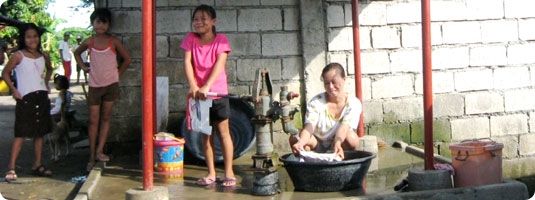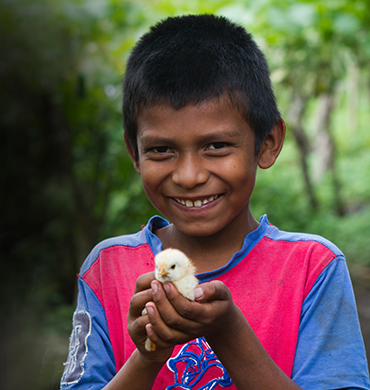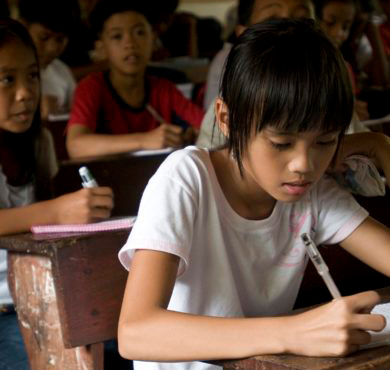Reducing Disaster Risk Through Sustainable Development in the Philippines

“Now we are enjoying the benefit of having more than enough water for bathing, cooking, washing clothes, and watering the plants. The water from our new well is very sweet… it seems there is sugar in it!”
– Marlyn Villaluz, farmer in Barangay San Carlos
Cabiao is a municipality in the province of Nueva Ecija, in the central plains of the Philippines. Although the land is fertile – the area is often referred to as the country’s “rice bowl” – typhoons are a common occurrence, and the most severe ones can wipe out an entire year’s crop.
After Typhoon Ondoy hit the country in 2009, the barangay (village) of San Vicente began a partnership with the Community-Based Development Program (CBDP) of the Episcopal Church in the Philippines and its partner, Episcopal Relief & Development, to rehabilitate local farms. The San Vicente Farmers’ Association took out a loan from the CBDP on behalf of its members for the purpose of buying seeds and replacing equipment that was destroyed by the storm.
The Farmers’ Association also partnered with the CBDP to build a drainage canal that would help prevent such catastrophic flooding in the future. The original plan was to construct a canal 300 meters (about 1,000 feet) in length, with materials provided by CBDP and labor done by community members. But the project got an unexpected boost from the local government, which offered to fund 20% of the total cost of the construction. With this contribution, the drainage canal was extended to a total of 450 meters (about 1,500 feet) and there was even money left over after the project was completed.
By investing cooperatively in projects initiated by the Church and carried out by community members, the socially-minded municipal government of Cabiao is helping its neighborhoods to grow and flourish. Rather than asking that the extra funds from the drainage canal be returned to the municipality, Mayor Gloria Crespo-Congco invited the CBDP to invest the surplus in additional development efforts. The first project involved installing artesian wells in areas of San Vicente where water was scarce. The CBDP provided funding for six wells, which the municipality matched with funding for an additional six, totaling 12 wells in all. Each of the wells is in an area easily accessible to at least five households, with members of those households contributing labor to complete the project. To be eligible for a well, the clusters of households agreed to plant vegetable gardens in the surrounding area. These gardens would be watered by overflow from the well and grey water from cooking and washing.
Meanwhile, the loan taken out by the Farmers’ Association for rehabilitation after the typhoon had been repaid in full, and the members’ positive experience with this system gave them the idea to establish a credit cooperative. With extra seed money from the CBDP, they were able to establish a fund of 200,000 Pesos (about 4,600 USD) to provide smaller loans for seeds, farm equipment and home improvements.
Word spread fast about the success of the projects in San Vicente, and how things were accomplished by simply getting people together to organize, plan and complete the work. In 2011, the Philippine Church and the municipal government replicated the matching program in three additional barangays: San Roque, Bagong Sikat and San Carlos. Following several discussions, the Church and Episcopal Relief & Development agreed to support the construction of 24 wells, and the municipality committed to match that effort with funding for an additional 11 wells. As before, clusters of households pledged to plant communal vegetable gardens around the wells, and as an added incentive, the municipality offered to provide “starter broods” of chickens that would grow and multiply into larger flocks.
The benefits of accessible water are numerous:
Consolacion from San Roque said, “Before the project, the members of my family and our neighbors often suffer[ed] from stomach pains and diarrhea because of the water we use[d]. Now we are happy that nobody has suffered from these diseases and we have our herbal and vegetable gardens as well.”
Teresita from Bagong Sikat said, “Our children are no longer late in going to school as their chore of fetching water from a far off source has stopped. They also go to school every morning freshly bathed and with clean clothes.”
And Aurillo, also from Bagong Sikat, said, “The well where we used to get water is very far… and most of the time, there’s a long line. A pail full of water usually reache[d] our house only half full as half is spilt in transit because of the distance. At night, we [could not] get water. There are times that we [did] not have water to wash ourselves when we [got] home from work from the fields, especially at night. Thanks be to God, these hardships are things of the past.”
Because of the new wells, nearly 8,000 people are now safe from waterborne disease. Children get to school on time, and they feel prepared and well rested. The hardship of transporting water a long distance is now a thing of the past, and the simple comfort of being able to wash after a long day of work is now a reality.
But perhaps most importantly, these projects have helped people gain confidence in their ability to make improvements in their communities. Shortly after work began on the second round of wells, a succession of typhoons hit the Philippines, destroying the vegetable gardens and washing away the gravel and sand which had been procured for construction. However, the people were undaunted. They pooled their resources and finished the projects where possible – only six wells remain to be built in Barangay San Roque, which will be done as soon as the flooding subsides.
Strengthened by their past successes and looking forward to greater achievements in the future, residents of Cabiao are committed to building back even better after the storms. Susan from San Carlos said, “We actually planted a lot of vegetables and even medicinal plants around the wells but most of the plants perished during the typhoons. Of course, we have replanted them again…and we aim to plant even more.”
“The program in Cabiao is exceptional,” said Nagulan Nesiah, Program Officer for Episcopal Relief & Development. “The mayor and municipality are genuinely interested in the welfare of the people there, and in improving things on a community level. They’re looking for ways to partner with existing projects and expand successful ones to other areas, which is what we do as well.”
“Also, our partners in Cabiao are addressing all four of our focus areas – hunger, health, disasters and economic opportunities – in one integrated program,” Nesiah continued. “This is a direction we’d like to see more of our programs move in, since development work helps to reduce the risk a disaster poses to a community, and helps it recover faster in case a disaster does happen. The loan fund pioneered in San Vicente after the 2009 typhoon was replicated in the other barangays when they were hit two years later, and having this model in place, as well as existing relationships with the Church, the municipality and us, is helping them to rebuild and keep growing.”


